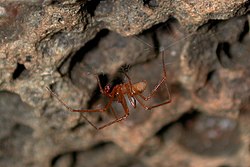| Nesticus | |
|---|---|
 | |
| male Nesticus sp. | |
| Scientific classification | |
| Kingdom: | Animalia |
| Phylum: | Arthropoda |
| Subphylum: | Chelicerata |
| Class: | Arachnida |
| Order: | Araneae |
| Infraorder: | Araneomorphae |
| Family: | Nesticidae |
| Genus: | Nesticus Thorell, 1869 |
| Type species | |
| Nesticus cellulanus Clerck, 1757 | |
| Species | |
125, see text | |
| Synonyms | |
| |
Nesticus is a genus of American and Eurasian scaffold web spiders first described by Tamerlan Thorell in 1869. [3]